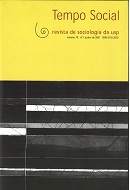Anatomia do entusiasmo: cultura e revolução em Cuba (1959-1971)
DOI:
https://doi.org/10.1590/S0103-20702007000100005Palabras clave:
Revolução, Intelectuais, Revistas, Periódicos, Literatura, Arte, CríticaResumen
Nas duas décadas que antecederam a revolução de 1959 em Cuba constituiu-se um campo intelectual, similar ao descrito por Pierre Bourdieu para a alta modernidade européia, baseado na autonomia da esfera pública, nas instituições acadêmicas e no mercado. O triunfo revolucionário e a radicalização socialista dos anos de 1960 transformaram esse campo por meio de uma politização da sociedade que, ao mesmo tempo que destruía e alargava as hierarquias e os limites sociais da cultura, reduzia a autonomia do campo e a pluralidade ideológica dos discursos nacionais. O objetivo deste artigo é investigar a reacomodação experimentada pelas relações entre os intelectuais e o poder durante a primeira década da revolução cubana.
Descargas
Referencias
ARRUFAT, Antón. (1959), “Las armas de la reacción”. Lunes de Revolución, 7 dez.
BERROS, Enrique. (1959), “Un cubano en la poesía”, Lunes de Revolución, 23 mar.
CABRERA INFANTE, Guilhermo. (1993), Mea Cuba. México, Vuelta.
CARPENTIER, Alejo. (1984), El siglo de las luces. Barcelona, Seix Barral.
CHE GUEVARA, Ernesto. (1971), El socialismo y el hombre en Cuba. México, Grijalbo.
DÍAZ, Duanel. (2003), Mañach o la república. La Habana, Letras Cubanas.
DÍAZ, Jesús. (2000), “El fin de otra ilusión”. Encuentro de la cultura cubana, n. 16/17, pp. 106-111, primavera/verão, Madri.
DOMÍNGUEZ, Jorge. (1978), Cuba: order and revolution. Harvard University Press, The Belknap Press.
EL CAIMÁN BARBUDO, n. 1, mar. 1966, p. 1, La Habana.
FRANCO, Jean. (2004), Decadencia y caída de la ciudad letrada: América Latina en la Guerra Fría. Barcelona, Debate.
FRANQUI, Carlos. (1972), “Respuesta de Carlos Franqui”. Libre, fev., pp. 9-10, FURET, François. (1995), El pasado de una ilusión. México, FCE.
GARCÍA BORRERO, Juan Antonio. (2001), Guía crítica del cine cubano de ficción. La Habana, Editorial Arte y Literatura.
GILMAN, Claudia. (2003), Entre la pluma y el fusil: debates y dilemas del escritor revolucionario en América Latina. Buenos Aires, Siglo XXI.
GRAMSCI, Antonio. (1971), La política y el Estado moderno. Barcelona, Península.
GUEVARA, Alfredo. (1998), Revolución es lucidez. La Habana, Ediciones ICAIC.
HABEL, Jinete. (1965), Proceso al sectarismo. Buenos Aires, Jorge Alvarez.
HERNÁNDEZ OTERO, Ricardo (org.). (1989), Revista Nuestro Tiempo, Compilación de trabajos publicados. La Habana, Letras Cubanas.
LA GACETA DE CUBA, n. 2, 1º maio 1962, pp. 2-7; n. 3, 15 maio 1962, pp. 4-5 e 15-16; n. 4, 5 jun. 1962, pp. 5-6; n. 19, 3 jun. 1963, pp. 3-6; n. 23, 26, 27, 28, 29, 30, 31, 32 e 33, de ago. 1963 a mar. 1964; n. 39, 5 jul. 1963, pp. 6-8 e 9-11; n. 40, out. 1964, pp. 6-7; n. 41, nov. 1964, pp. 12-16.
LUIS, William. (2003), Lunes de Revolución: literatura y cultura en los primeros años de la Revolución Cubana. Madri, Verbum.
MAÑACH, Jorge. (1961), “José Martí: rompeolas de América”. Bohemia Libre, 23 jul., pp. 7 e 95.
MARINELLO, Juan. (1984a), “Sobre la Revista de Avance y su tiempo”. In: Obras. Cuba: Cultura. La Habana, Letras Cubanas, pp. 90-107.
MARINELLO, Juan. (1984b), “A medio siglo de la Revista de Avance”. In: Obras. Cuba: Cultura. La Habana, Letras Cubanas, pp. 273-303.
MARTÍNEZ PEREZ, Liliana. (2006), Los hijos de saturno: intelectuales y revolución en Cuba. México, Porrúa.
PADILLA, Heberto. (1959a), “Mañach y la Marina”. Lunes de Revolución, 2 nov.
PADILLA, Heberto. (1959b), “La poesía en su lugar”. Lunes de Revolución, 7 dez.
PADILLA, Heberto. (1998), Fuera del juego. Edición conmemorativa, 1968-1998. Miami, Ediciones Universal.
PENSAMIENTO CRÍTICO, n. 30, 30 jun. 1969, pp. 3-4, La Habana; n. 39, abr. 1970, pp. 104-105, 214-216 e 321-322; n. 1, fev. 1967, Instituto del Libro; n. 18/19, 1968, pp. 3-7, Instituto del Libro; n. 34/35, nov.-dez. 1969, pp. 3-51; n. 21, 1968, pp. 191-205, Instituto del Libro.
QUINTERO HERENCIA, Juan Carlos. (2002), Fulguración del espacio: letras e imaginario institucional de la revolución cubana (1960-1971). Buenos Aires, Beatriz Viterbo.
REED, Roger. (1991), The cultural revolution in Cuba. University of Geneva Press, Latin American Round Table.
ROA, Raúl. (1969), La revolución del 30 se fue a bolina. La Habana, Instituto del Libro.
RODRÍGUEZ, Carlos Rafael. (1983), Letra con filo. La Habana, Editorial de Ciencias Sociales, vol. II.
ROJAS, Rafael. (1999), Isla sin fin: contribución a la crítica del nacionalismo cubano. Miami, Ediciones Universal.
ROJAS, Rafael. (2006), Tumbas sin sosiego: revolución, disidencia y exilio del intelectual cubano. Barcelona, Anagrama.
RUIZ, Ramón Eduardo. (1972), Cuba: génesis de una revolución. Barcelona, Editorial Noguer.
SALISBURY, Harrison Evan. (1992), The new emperors: China in the era of Mao and Deng. Londres, Little, Brown and Company.
STABLE, Marifeli Pérez. (1998), La revolución cubana: orígenes, desarrollo y legado. Madri, Editorial Colibrí.
STAROBINSKI, Jean. (1988), 1789. Los emblemas de la razón. Madri, Taurus.
THOMAS, Hugo. (1995), La guerra civil española. Barcelona, Grijalbo Mondadori, vol. I.
VEIGAS, José, VIVES, Cristina & NODAL, Adolfo. (2002), Memoria: cuban art of the 20th Century. International Arts Foundation.
VERDÉS-LEROUX, Jeannine. (1989), La lune et le caudillo: le rève des intellectuels et le régime cubain (1959-1971). Paris, Gallimard.
Descargas
Publicado
Número
Sección
Licencia
Derechos de autor 2015 Tempo Social

Esta obra está bajo una licencia internacional Creative Commons Atribución-NoComercial 4.0.


